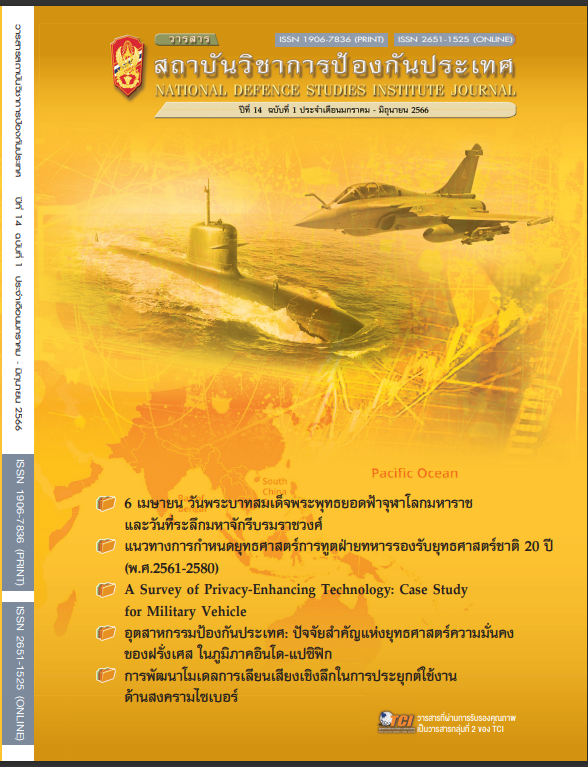A Survey of Privacy-Enhancing Technology: Case Study for Military Vehicle
Main Article Content
Abstract
Privacy-enhancing technologies (PETs) are instrumental tools, techniques, and practices aimed at safeguarding individuals' privacy by mitigating risks associated with data collection, storage, and processing. Their deployment extends to military contexts, where protection of sensitive information and operational security hold paramount importance. PETs enable military organizations to ensure the confidentiality, integrity, and availability of highly classified and sensitive data. Anonymity and pseudonymity technologies, data encryption and cryptography, privacy-enhancing communication protocols, trusted execution environments, privacy-focused web browsers and search engines, privacy-aware mobile applications, and blockchain-based PETs are some of the key types of PETs. These technologies deliver benefits such as privacy protection, data security, transparency, trust, compliance, and innovation. Two case studies exemplify the application of PETs: the first study analyzes a pseudonym-based approach to conceal the real identity of military vehicles, demonstrating superior time efficiency and secure communication, while the second study introduces the SecVLC protocol that addresses privacy and security concerns in visible light communication, promising enhanced security through directional transmission and secure key generation.
Article Details

This work is licensed under a Creative Commons Attribution-NonCommercial-NoDerivatives 4.0 International License.
บทความ ภาพ ตาราง กราฟ ข้อเขียน หรือความคิดเห็นในวารสารฉบับนี้เป็นของผู้เขียนไม่ผูกพันกับสถาบันวิชาการป้องกันประเทศ และทางวิชาการแต่อย่างใดReferences
Alibaba Tech. (2019). Alibaba. Retrieved form https://102.alibaba.com/detail/?id=367&mtime=1563847710000
Akande, O. N., Abikoye, O. C., Kayode, A. A., Aro, O. T., & Ogundokun, O. R. (2020). A Dynamic Round Triple Data Encryption Standard Cryptographic Technique for Data Security. In Gervasi, O., Murgante, B., Misra, S., Garau, C., Blečić, I., Taniar, D., …, Karaca, Y. (Eds.), Proceeding Computational Science and Its Applications-ICCSA 2020 (487-499). Retrieved form https://doi.org/10.1007/978-3-030-58817-5_36
Android Open Source Project. (2021). Trusty TEE. Retrieved form https://source.android.com/docs/security/features/trusty
Apple Platform Security. (2021). Secure Enclave. Retrieved form https://support.apple.com/en-gb/guide/security/sec59b0b31ff/web
Borgolte, K. & Feamster, N. (2020). Understanding the Performance Costs and Benefits of Privacy-focused Browser Extensions. In Huang, Y., King, I., Liu, T. Y., Steen, M. V. (Eds.), WWW '20: Proceedings of The Web Conference 2020 (2275-2286). Retrieved form https://doi.org/10.1145/3366423.3380292
GlobalPlatform. (2016). GlobalPlatform Welcomes New Participating Member Beijing Beanpod Technology. Retrieved form https://globalplatform.org/latest-news/globalplatform-welcomes-newparticipating-member-beijing-beanpod-technology/
_______. (2018). WatchTrust 2.1.1 on SC9860. Retrieved form https://globalplatform.org/wp-content/uploads/2018/09/GP-TEE-2018_01-CR-1.0_GP170003-Certificate-Certification-Report_20180904-signed-1.pdf
_______. (2020). Samsung TEEgris v4.1 on Exynos 990/980 devices. Retrieved form https://globalplatform.org/wp-content/uploads/2020/10/GP-TEE-2020_01-CR-1.0_GP200007-Certificate-and-CertificationReport_20200922.pdf
Huawei. (2019). HUAWEI Privacy. Retrieved form https://consumer.huawei.com/en/privacy/certification/
Information Commissioner’s Office. (2022). Privacy-enhancing technologies (PETs). Retrieved form https://ico.org.uk/media/about-the-ico/consultations/4021464/chapter-5-anonymisation-pets.pdf
Javed, I. T., Alharbi, F., Margaria, T., Crespi, N. & Qureshi, K. N. (2021). PETchain: A Blockchain-Based Privacy Enhancing Technology. IEEE Access, 9, Retrieved form https://doi.org/10.1109/ACCESS .2021.3064896
Linaro. (2021). Trustzone and OP-TEE. Retrieved form https://www.linaro.org/services/security/
Lockey, T. (n.d.). Top Ten Privacy Enhancing Technologies. Retrieved form https://www.techyv.com/article/top-ten-privacy-enhancing-technologies/
Makin, D.A. & Ireland, L. (2020). The secret life of PETs: A cross-sectional analysis of interest in privacy enhancing technologies. Policing: An International Journal, 43(1), Retrieved form https://doi.org/10.1108/PIJPSM-07-2019-0124
Qualcomm. (2021). Guard your Data with Qualcomm Snapdragon Mobile Platform. Retrieved form https://www.qualcomm.com/content/dam/qcomm-martech/dm-assets/documents/guard_your_data_with_the_qualcomm_snapdragon_mobile_platform2.pdf
Sardá, T., Natale, S., Sotirakopoulos, N., & Monaghan, M. (2019). Understanding online
Anonymity. Media, Culture & Society, 41(4), Retrieved form https://doi.org/10.1177/0163443719842074
Sucasas, V., Mantas, G., Bastos, J., Damião, F., & Rodriguez, J. (2019). A Signature Scheme with Unlinkableyet-Accountable Pseudonymity for Privacy-Preserving Crowdsensing. IEEE Transactions on Mobile Computing, 19(20), Retrieved form https://dl.acm.org/doi/10.1109/TMC.2019.2901463
Tandon, R., & Gupta, P. K. (2021). A Novel Pseudonym Assignment and Encryption Scheme for Preserving the Privacy of Military Vehicles. Defence Science Journal, 71(2), Retrieved form https://doi.org/10.14429/dsj.71.15534
Ucar, S., Ergen, S. C , Ozkasap, O., Tsonev, D., & Burchardt, H. (2016). SecVLC: Secure Visible Light Communication for Military Vehicular Networks. In Cuevas, A., Chatzimisios, P., & Grande, R. D. (Eds.), MobiWac '16: Proceedings of the 14th ACM International Symposium on Mobility Management and Wireless Access (123-129). Retrieved form https://doi.org/ 10.1145/2989250.2989259
Xiong, L., Li, F., He, M., Liu, Z. & Peng, T. (2020). An Efficient Privacy-Aware Authentication Scheme With Hierarchical Access Control for Mobile Cloud Computing Services. IEEE Transactions on Cloud Computing, (10)4, Retrieved form https://doi.org/10.1109/TCC.2020.3029878

